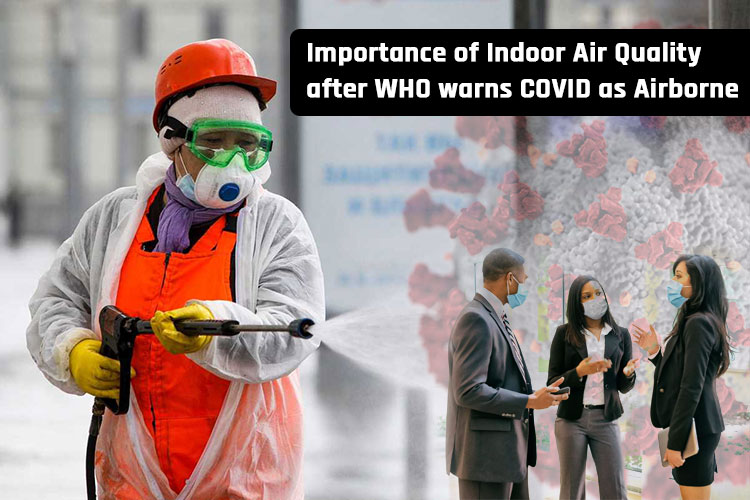Importance of Indoor Air Quality after WHO warns COVID as Airborne

The airborne transmission of coronavirus has been a broadly discussed topic among clinical experts and analysts. From the start, the prevention direction concentrated on maintaining a safe distance from droplets of infected people when they cough or sneeze, while keeping surfaces and articles cleaned. Nonetheless, there is a new discovery that airborne COVID-19 disease is conceivable through particles called aerosols. These particles can reach high concentrations in inadequately ventilated spaces, expanding the danger of disease.
It is advisable to get your indoor air quality checked for prevention against COVID-19.
Initially, direction from the World Health Organization (WHO) concentrated on forestalling contamination by droplets and surfaces, and airborne transmission was not viewed as a noteworthy hazard. Nonetheless, the most recent direction from the WHO perceives the danger of COVID-19 by exposure to aerosols in the air.
With the danger of airborne COVID-19, indoor air quality becomes an important aspect in building structures. ASHRAE has given direction on the best way to improve IAQ and lessen the danger of spread. The guidance has been given according to the building type, however, there are a few in general.
- Increase ventilation with open air, with zero air recirculation whenever the situation allows.
- Redesigning air channels to clinical evaluation, which implies MERV 13 or better.
- Air and surface sanitization with Ultraviolet Germicidal Irradiation.
The infection-spreading mechanism of the new coronavirus is not completely comprehended. In any case, airborne transmission appears to be almost certain in the interior of buildings, particularly if they have high occupancy and lacking ventilation.
- When the number of tenants staying in the building is high, the possibility of having COVID-19-infected people is higher.
- Insufficient ventilation implies that viral particles are not expelled from the air adequately. This increases the exposure to the infection.
Occupancy can be reduced in the buildings with stay-at-home requests, telling organizations to utilize teleworking as much as possible. Thus, infection spread can be decreased automatically as people would not be interacting in a closed environment.
Ventilation enhancements rely upon the current HVAC systems. A few frameworks can be effectively reconfigured, while others may require upgrades to give satisfactory ventilation. However, ASHRAE suggests increasing the outdoor air circulation inside as much as possible, while decreasing or eliminating indoor air recirculation. Outdoor air usually does not ordinarily contain coronavirus particles, and an increased air supply can weaken air toxins. With diminished distribution, outside air can uproot indoor air that has been accumulating viral particles.
Filter updates and UVGI can give extra protection against COVID-19 disease: clinical grade filters can catch a high level of air particles, while UV light can eliminate germs by obliterating their DNA. It is important that the building proprietors utilize the correct items: filters of at least MERV 13 rating, and UVGI frameworks must utilize UV-C light explicitly.
To improve indoor air quality, the best beginning is a professional audit of the property. Contingent upon the sort of ventilation framework and the HVAC design, the best measures can be taken. For instance, HVAC frameworks that are constrained by a Building Automation System (BAS) can be effectively reconfigured, while frameworks without smart controls will require manual alterations.
Increasing the outside airflow is valuable for air quality, yet this might be constrained by climate conditions. For instance, if the open air is hot or chilly, a high wind current may overpower the cooling or space heating system. This may cause indoor temperatures that are unsatisfactory for the occupants.
Redesigning air filters is just suggested after a fan inspection, or you can end up introducing filters that limit wind current. Using MEP BIM Services appropriately can help you design a system as per professional guidance. Rather than improving air quality, the former will result in having an inconvenient impact. Professional direction is additionally vital while conveying UVGI, since bright light can cause eye or skin harm with erroneous use.